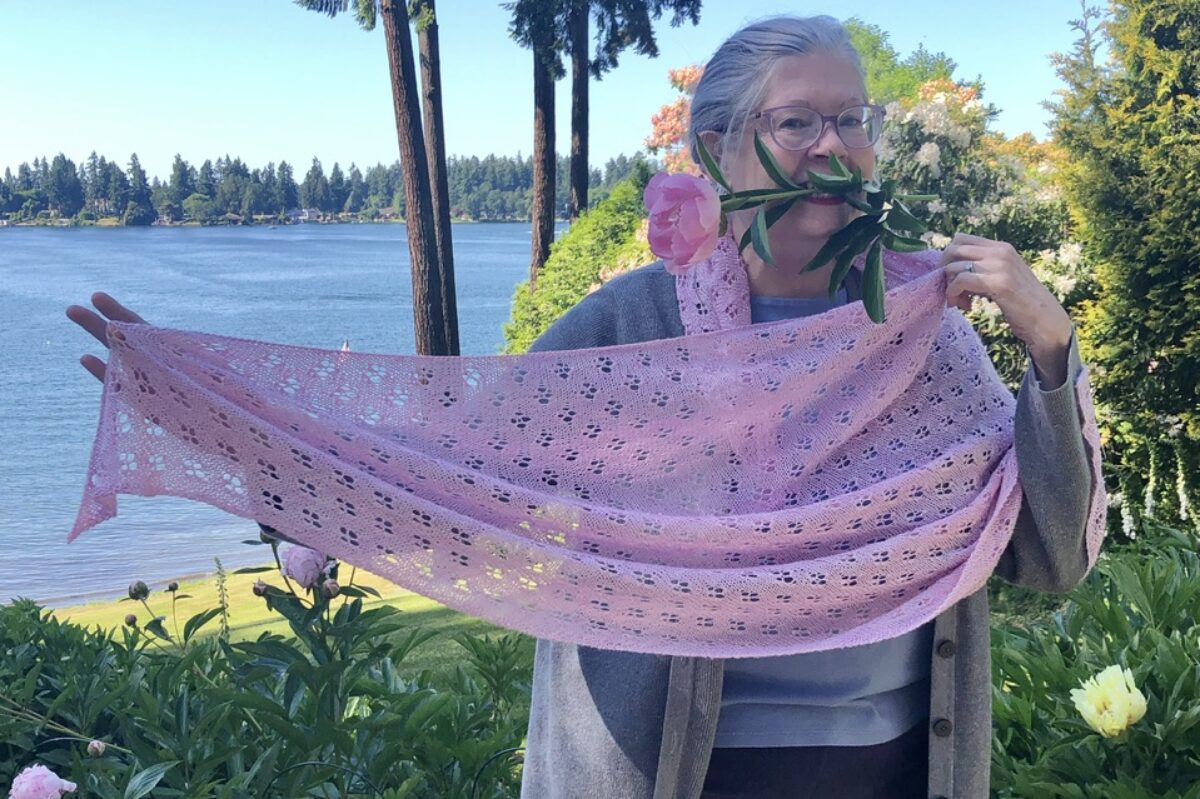And, A Finished Project!
Earlier this spring, I signed up for a novel CSA* project. It’s from Birdsong at Nature’s Cauldron, and it’s a natural dye plant CSA share. The first shipment arrived last week, and contained a big skein of yarn, and several different paper sacks, all loaded with a variety of dried plants useful for dyeing fiber. This shipment contained comfrey root, fennel, some lodgepole pine bark, and a lichen. I could hardly wait until I had a day off so I could play. Here’s the photo evidence of my first effort.
I decided to try dyeing unspun roving first. This is 4 ounces of undyed Polwarth, soaking in the sink pre-mordanting.
That’s the pot, ready to go. I spent the last few weeks before the first shipment came collecting tools. Fortunately we have a second tiny kitchen in our basement, so I can keep the dye equipment and supplies out of our food prep kitchen.
Fennel chopped up and ready to go. We just happened to have a bunch of fresh fennel in our food CSA box this week as well, so the tops and stems went in as well as the dried stuff.
Here’s the fiber in the mordant pot. With most natural dyes, you have to pre-treat, or mordant the fiber with one of a variety of chemicals to make the dye stick and help with the colorfastness. This is an iron mordant, which also changes the color of the finished fiber. With iron, this is called “saddening” the color since it dulls it and makes it more of an earthy color instead of a bright clear color.
The mordanted fiber:
That’s the fennel cooking. This smells nothing like the bulb of the fennel plant. After this had cooked for awhile, I got online and ordered a hotplate so that in the future I can do this outside. It just plain stinks.
I simmered this for about 90 minutes, then turned it off and let it sit overnight, then repeated the cooking the next morning, after opening all the doors and windows. Here’s the strained dyepot, ready to go.
That’s the fiber, out of the pot, on my improvised hammock drying rack. And here’s the finished fiber:
That’s pretty close to the real color. If you’ve ever seen an old army blanket, this is the exact same color, so it’s officially Army Blanket Green. I think this will make a swell hat or a scarf.
Project Details:
Fiber: Polwarth, 115 grams.
Mordant: Ferrous Sulfate, purchased from Griffin Dyeworks. I used 11 grams of the iron, or 10% of the fiber weight. I heated the iron in water to dissolve it, then simmered the fiber in it for 90 minutes, and rinsed.
Dye: Fennel tops and stalks, both dried and fresh. I had 577 grams of fennel total. The dye pot was prepared by boiling the fennel in water for 90 minutes, turning off overnight, then repeating in the morning. I soaked the fiber in water, then added it to the dye pot, brought to a simmer for 90 minutes, cooled, then rinsed and dried.
What I Learned: This was more fun than a barrel of monkeys. It’s really much like running a chemistry experiment, with the added bonus that you get yarn to play with at the end. This really appeals to the weirdo mad scientist in me that never got to have a chemistry kit as a kid.
Next up?** The skein of yarn that was included in this shipment was pre-mordanted with rhubarb, so it’s ready to dye. I also have another skein of my handspun that is undyed, and lots more plain roving, so tomorrow’s experiment is going to be with madder root (not in the shipment, but I had ordered some to play with). I’ll report back with the results of the experiment when it’s done!
*CSA=Community supported agriculture
**Yes, I’m still working on that baby blanket.










I think I’d like to see those two colors together- or, at the very least, next to each other. Very natural and earthy, and pretty!
Dyeing of any sort is just generally stinky! I would never have guessed you could use fennel to dye.
That is a cool project!! I like the fennel green color.
What fun! Great fiber color. I collected hickory nuts, leaves, lichen laden bark chips and and oak galls after Hurricane Irene’s fury died down. I plan on some dyeing fun later in the week. Thanks for the ferrous sulfate link.
Can’t wait to see that spun up. Lovely natural colors. And yes, I WAS disappointed that the FO wasn’t the dang blanket!
Ooooh, you’ll have to show me when I get there! Leaving for Oregon later this morning… so much to do and see.
Can’t wait to get to Seattle. 🙂
Fun! And here I had thought fennel was great in salads, but that was it. Silly me. My daughter did a t-shirt using marigolds, and it came out a lovely color, which remained fast for years. That is our only genuine plant dying adventure.
How adventurous, and such a pretty green, too. On another note, I was cleaning up my stash today, and came across the bag of leftovers from my Icelandic Shawl. I think that except for one color, there is enough to make another. If you’d like them, let me know.
That’s awesome and amazing too. I love the green!!
That is so cool! I was wondering what to do with my fennel. Oh… and I’m only slightly miffed that you didn’t name it “Marine Corps green”
; O
I love that — everything!! ; )
Oh, you didn’t really say that, did you? I always wanted a chemistry set as a kid, too — but I do NOT want to go down the dyeing rabbit hole! (Then again, maybe I do…)